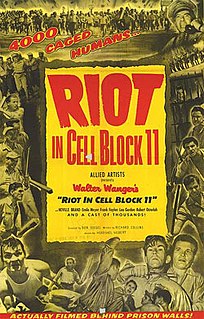Related Research Articles

The New Mexico State Penitentiary riot, which took place on February 2 and 3, 1980, at the Penitentiary of New Mexico (PNM) south of Santa Fe, was the most violent prison riot in U.S. history. Inmates took complete control of the prison and twelve officers were taken hostage. Several inmates were killed by other prisoners, with some being tortured and mutilated because they had previously acted as informants for prison authorities. Police regained control of PNM 36 hours after the riots had begun. By then, thirty-three inmates had died and more than two hundred were treated for injuries. None of the twelve officers taken hostage were killed, but seven suffered serious injuries caused by beatings and rapes.

The Carandiru massacre occurred on Friday, 2 October 1992, in Carandiru Penitentiary in São Paulo, Brazil, when military police stormed the penitentiary following a prison riot. The massacre, which left 111 prisoners dead, is considered by many people to be a major human rights violation.

Pul-e-Charkhi Prison, also known as the Afghan National Detention Facility, is the largest prison in Afghanistan, located in the outskirts east of Kabul. As of 2018, it holds up to 5,000 inmates. The prison became notorious for torture and executions after the 1978 Saur Revolution as well as during the 10 year Soviet war that followed. Some claim that between April 1978 and December 1979, the communist People's Democratic Party of Afghanistan (PDPA) under Nur Muhammad Taraki, executed around 27,000 political prisoners at Pul-i-Charkhi. More recently, the Afghan National Army's 111th Capital Division was based near Pul-e-Charkhi prison.

The Penitentiary of New Mexico (PNM) is a men's maximum-security prison located in unincorporated Santa Fe County, 15 miles (24 km) south of central Santa Fe, on New Mexico State Road 14. It is operated by the New Mexico Corrections Department.

Riot in Cell Block 11 is a 1954 American film noir crime film directed by Don Siegel and starring Neville Brand, Emile Meyer, Frank Faylen, Leo Gordon and Robert Osterloh. Quentin Tarantino called it "the best prison film ever made."
Centro de Rehabilitación Santa Cruz "Palmasola" is a maximum security prison in Santa Cruz, Bolivia. It is Bolivia's largest prison and holds about 3,500 prisoners. Like many prisons in Latin America, guards exhibit minimal control over what happens within the prison, leading it to being described as a "prison town". Guards instead concentrate only on securing the perimeter of the facility. According to former inmates, almost anything can be obtained in the prison, and businesses operate inside the prison to supply weapons and drugs. Prisoners of Palmasola have created an organization called the Disciplina Interna to oversee some affairs.
San Pedro prison or El penal de San Pedro is the largest prison in La Paz, Bolivia and is renowned for being a society within itself. Significantly different from most correctional facilities, inmates at San Pedro have jobs inside the community, buy or rent their accommodation, and often live with their families. The sale of cocaine base to visiting tourists gives those inside a significant income and an unusual amount of freedom within the prison walls. Elected leaders enforce the laws of the community, commonly through stabbing. The prison is home to nearly 3,000 inmates, with additional guests staying in the prison hotel.

Michigan State Prison or Jackson State Prison, which opened in 1839, was the first prison in Michigan. After 150 years, the prison was divided, starting in 1988, into four distinct prisons, still in Jackson: the Parnall Correctional Facility which is a minimum-security prison; the G. Robert Cotton Correctional Facility where prisoners can finish their general education; the Charles Egeler Reception and Guidance Center which is the common point of processing for all male state prisoners sentenced to any Michigan prison; and the Cooper Street Correctional Facility which is the common point for processing of all male state prisoners about to discharge, parole, or enter a community center or the camp program.
A prison riot occurred at the CERESO state prison in Ciudad Juárez, Chihuahua, Mexico, on March 4, 2009. During the riots, at least 20 people were killed and 15 were injured. Although a police spokesman stated that no police or jail guards were killed during the riots, the Red Cross said that two policemen had been killed. The riot was a fight among several rival gangs, the "Barrio Azteca," "Los Mexicles" and "Artistas Asesinos" (AA).

The State Correctional Institution (SCI) at Camp Hill, commonly referred to as SCI Camp Hill, is a Pennsylvania Department of Corrections prison in Lower Allen Township, Cumberland County, near Camp Hill in Greater Harrisburg. Its Superintendent is Laurel Harry. It has around 3,400 inmates.

The Apodaca prison riot occurred on 19 February 2012 at a prison in Apodaca, Nuevo León, Mexico. Mexico City officials stated that at least 44 people were killed, with another twelve injured. The Blog del Narco, a blog that documents events and people of the Mexican Drug War anonymously, reported that the actual (unofficial) death toll may be more than 70 people. The fight was between Los Zetas and the Gulf Cartel, two drug cartels that operate in northeastern Mexico. The governor of Nuevo León, Rodrigo Medina, mentioned on 20 February 2012 that 30 inmates escaped from the prison during the riot. Four days later, however, the new figures of the fugitives went down to 29. On 16 March 2012, the Attorney General's Office of Nuevo León confirmed that 37 prisoners had actually escaped on the day of the massacre. One of the fugitives, Óscar Manuel Bernal alias La Araña, is considered by the Mexican authorities to be "extremely dangerous," and is believed to be the leader of Los Zetas in the municipality of Monterrey. Some other fugitives were also leaders in the organization.
The British Columbia Penitentiary was a federal maximum security prison located in New Westminster, British Columbia, Canada. The BC Penitentiary operated for 102 years, from 1878 until it was decommissioned in 1980. It was the first federal penal institution west of Manitoba. Gate house was sold on September 8,2021 and was renamed Governors Castle by new owners Vikram Bajwa and Sunny Sodhi. Colliers international Appraised the Building at $8,950,000,additional open space for $4,500,00, totaling $13,450,000. at time of purchase by Governors Court Inc.
On 20 August 2012, armed prisoners in the Yare I prison complex, an overcrowded prison in Miranda state near Caracas, Venezuela, rioted. A shootout between two groups resulted in the deaths of 25 people, one of them a visitor. Among those injured during the incident were 29 inmates and 14 visitors.

On 10 February 2016, a prison riot broke out at the Topo Chico prison near Monterrey, in northern Mexico. 49 inmates were killed during the riot and ensuing fire. The riot was the most deadly in Mexican penal history, surpassing the death toll of the 2012 Apodaca prison riot. After the rioting, authorities uncovered 'luxury cells' prison leaders had. Among the items confiscated included televisions, mini-fridges, aquariums, and saunas.
The 2017 Brazil prison riots were a confrontation between two criminal organizations, the Primeiro Comando da Capital (PCC) and Comando Vermelho (CV), and their allies within prisons and peripheries of Brazilian cities. Its emergence is linked to the methods of the PCC to conquer new territories for drug trafficking, which involve the collection of insurance and economic centralization and whose rigid pseudo-state organization finds strong resistance from regional criminal organizations, with predominantly decentralized organization.

On March 28, 2018, a fire broke out during a prison riot in the cells at the Carabobo state police headquarters in Valencia, Carabobo, Venezuela. The fire killed at least 68 people and injured scores of others. The fire is one of the deadliest incidents ever in a Venezuelan prison since the 1994 Sabaneta prison fire, in which more than 100 inmates died.

A group of inmates were involved in a prison riot on 24 May 2019 in the police station cellblocks in Acarigua, Portuguesa state, Venezuela. The riot allegedly began when inmate Wilfredo Ramos was killed following ten days of protests against the denial of visits by relatives.
The Altamira prison riot occurred on 29 July 2019, when a riot broke out at the Centro de Recuperação Regional de Altamira prison in Altamira, Pará, Brazil, due to drug turf disputes between rival gangs within the prison.
On 23 February 2021, 79 inmates were killed and several others were injured in riots that took place simultaneously in four prisons in Ecuador. Authorities gave gang rivalry in an overcrowded prison system as the cause. The violence happened in prisons located in the Guayas, Azuay and Cotopaxi provinces, which contain nearly 70% of the total prison population in the country.
On 28 June 2022, a fire broke out during a riot inside a prison in Tuluá, Colombia killing at least 52 people and injuring at least 34.
References
- 1 2 3 4 5 6 7 "At least 30 dead, 60 hurt in fiery battle between rival inmates in Bolivia prison". Washington Post. AP. August 23, 2013. Archived from the original on August 24, 2013. Retrieved August 24, 2013.
- ↑ "Bolivia prison riot leaves at least 29 dead". BBC News. 23 August 2013.
- 1 2 Wells, Miriam (26 August 2013). "Bolivian Prison Riot Highlights LatAm Penitentiary Chaos". InSight Crime . Retrieved 27 August 2013.
- ↑ Ramsey, Geoffrey (20 January 2012). "Overcrowding Allows Bolivia's Prison Gangs to Flourish". InSight Crime. Retrieved 27 August 2013.
- 1 2 3 4 5 6 7 8 "Mueren 29 reos y un niño en la más cruenta reyerta carcelaria en Bolivia". Bolpress. August 24, 2013. Archived from the original on September 13, 2013. Retrieved August 25, 2013.
- 1 2 3 4 5 6 "Bolivia prison riot death toll rises". BBC. August 24, 2013. Retrieved August 24, 2013.
- ↑ Pierre Meilhan (August 24, 2013). "Dozens killed in Bolivia prison fire, brawl". CNN. Retrieved August 24, 2013.
- 1 2 "Aumenta a 31 la cifra de muertos por matanza en Palmasola" [The death toll in Pamasola killings increases to 31]. AP. August 25, 2013. Archived from the original on August 26, 2013. Retrieved August 25, 2013.